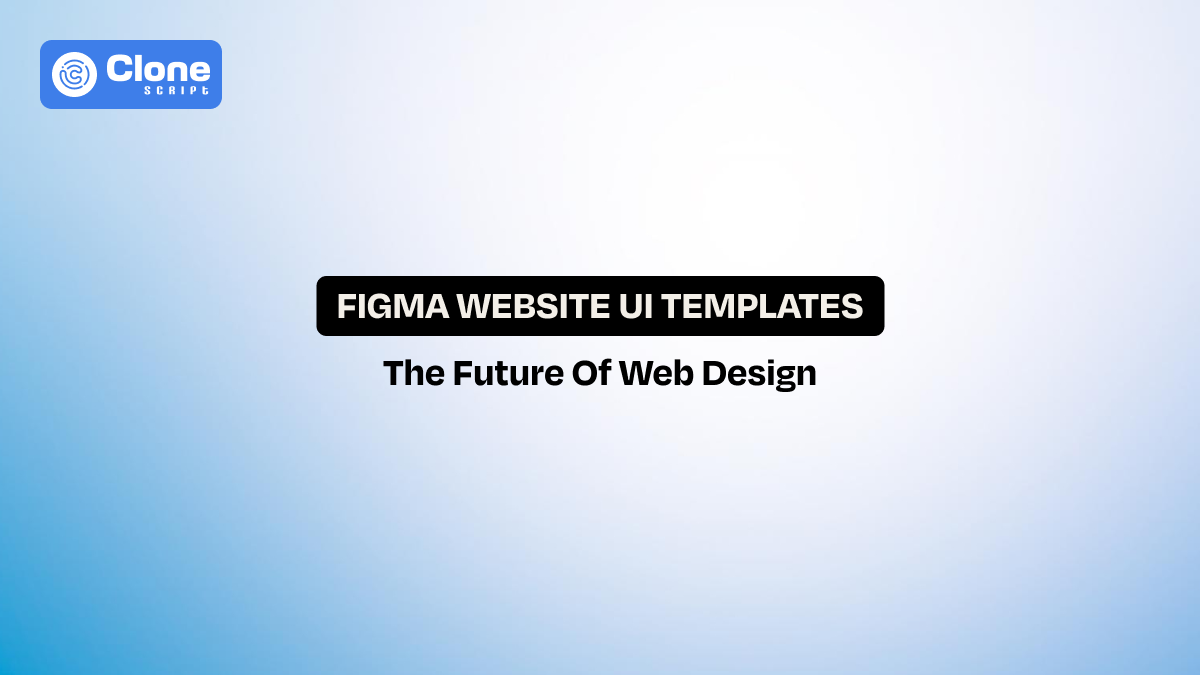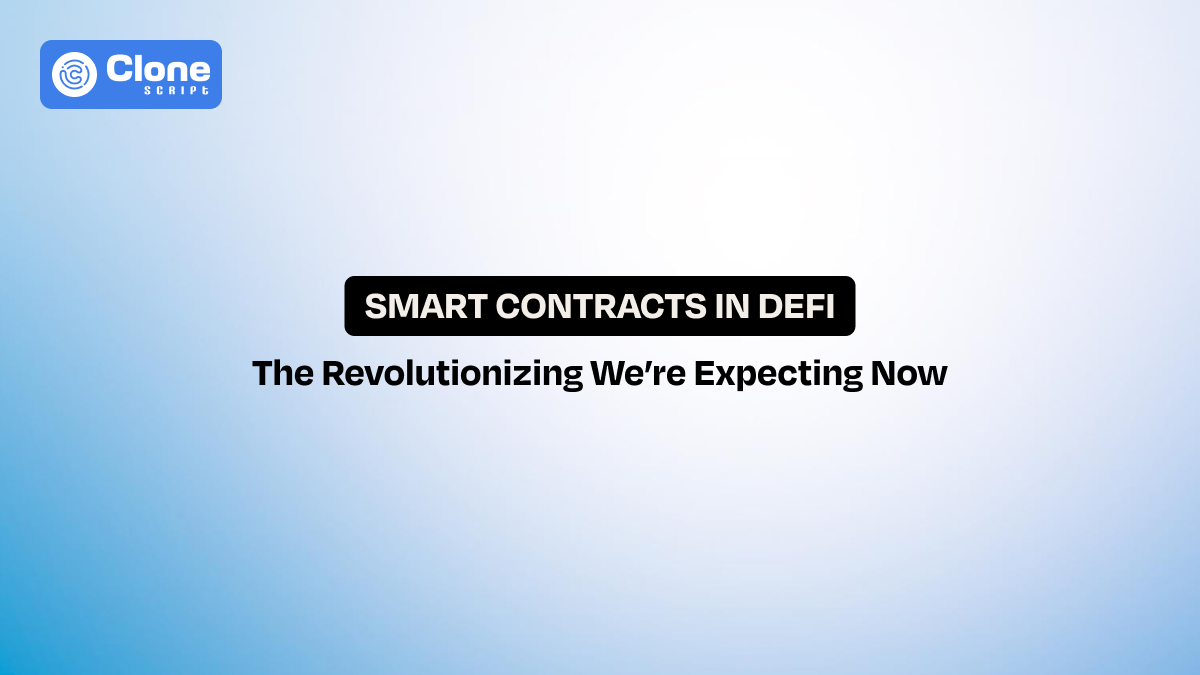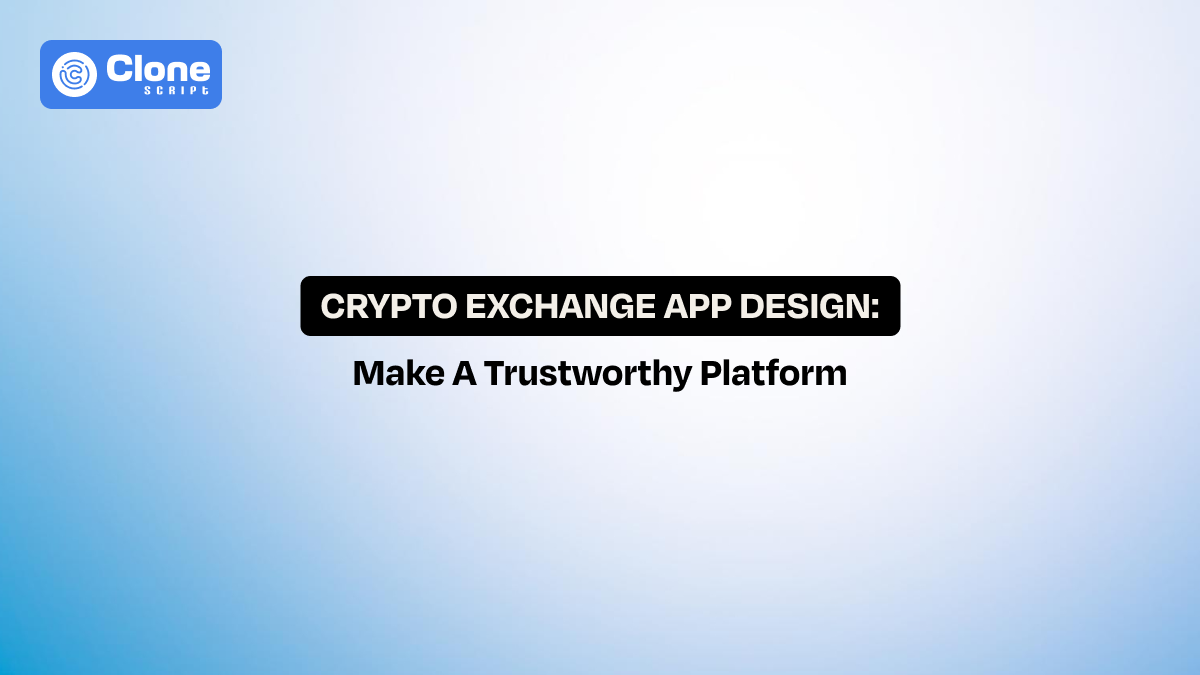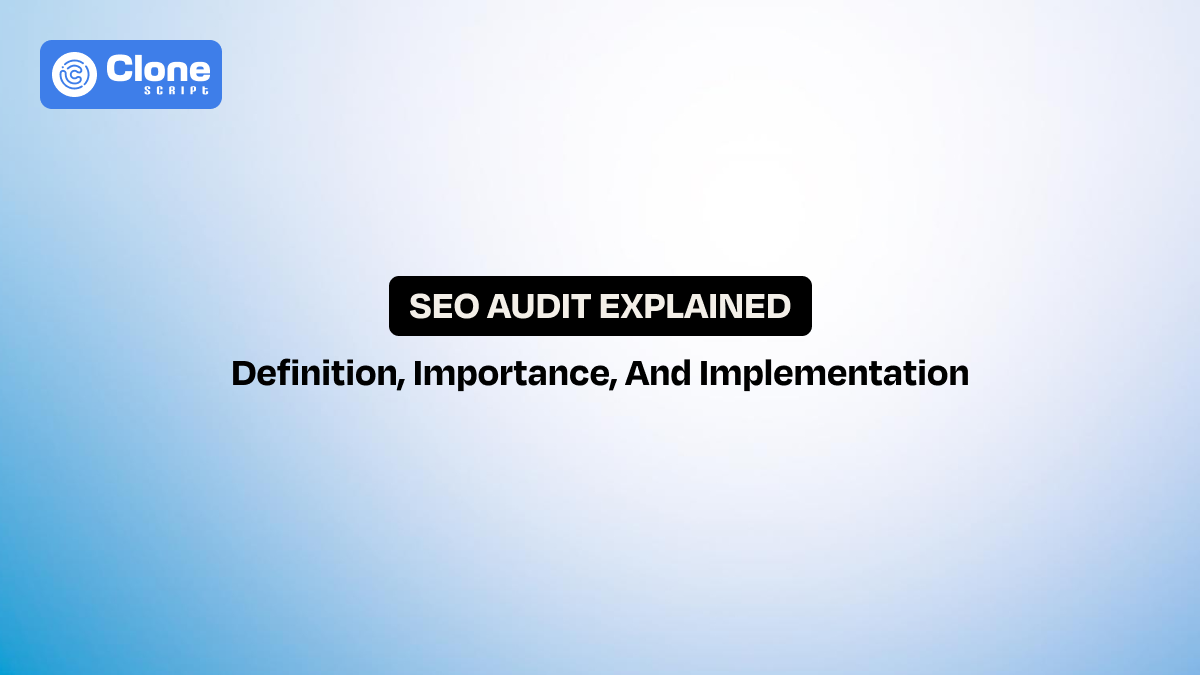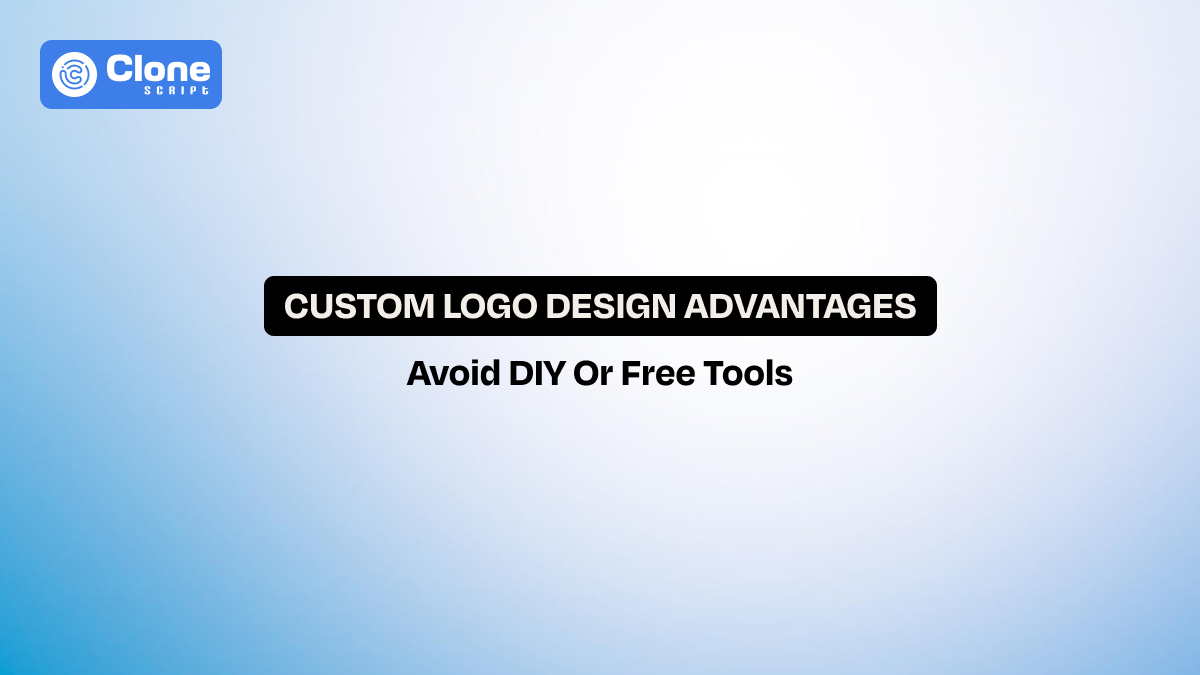A Complete Guide to Smart Contracts Website Development for Businesses (2025)
The Web3 introduction and cryptocurrency adoption are causing more and more businesses to go towards the Decentralized Finance (DeFi) ecosystem. The smart contract plays a key role in this DeFi system. These contracts are not just like a traditional agreement between the two parties. But they’re self-executed when the pre-built condition applies.
If you’re looking to make a website where users can create smart contracts and deploy them to the blockchain, this article will help you with that. We will understand everything from the smart contract website components that allow it to work properly, and the common challenges most developers face.
What is Smart Contracts Website Development?
A smart contract website development is a process to create a digital platform that combines a traditional frontend with blockchain’s decentralized backend. Unlike regular websites, these platforms don’t just display information or process forms; they automate transactions, apply rules, and ensure tamper-proof records.
For example, if a buyer sends payment in BTC, the smart contract instantly releases ownership of the asset to the receiver’s wallet. No manual verification required.
In practice, the development involves:
-
Blockchain integration: Choosing a network like Ethereum, Polygon, or Solana to host contracts.
-
Smart contract coding: Writing business logic in languages such as Solidity or Rust.
-
Frontend and middleware: Building user-friendly interfaces that connect to wallets like MetaMask using libraries like Web3.js or Ethers.js.
This combination of blockchain and web development enables businesses to launch decentralized apps (dApps), handle digital payments, track supply chains, and even manage tokenized assets — all with greater security and trust.
6 Key Components of a Smart Contract Website
A smart contract website isn’t just a digital presence — it’s a complete ecosystem where blockchain logic, web interfaces, and security frameworks work together to deliver automation and trust. To build one effectively, developers need to consider several key components:
1. Blockchain Network
The blockchain serves as the foundation. Networks like Ethereum, Polygon, Solana, and Binance Smart Chain are commonly used, each with trade-offs.
2. Smart Contract Layer
This is the business logic engine of the website. Written in Solidity, Vyper, or Rust, smart contracts execute rules automatically. This reduces administrative overhead and ensures that the system enforces policies consistently.
3. Frontend Interface
A smart contract website must be easy to use — otherwise, adoption will be limited. Developers often use React.js, Angular, or Vue.js to build intuitive interfaces called frontend website development. These connect with blockchain networks through tools like Web3.js or Ethers.js, allowing users to interact with contracts directly from the browser.
4. Middleware & APIs
Middleware acts as a bridge between blockchain and traditional web systems. APIs help the website talk to external services. Without these connectors, a blockchain website would feel improper in the broader digital ecosystem.
5. Wallet Integration
The importance of crypto wallets is central to user interaction. MetaMask, Trust Wallet, and WalletConnect allow users to sign transactions and authenticate securely.
6. Security Protocols
Since blockchain transactions are irreversible, security is non-negotiable. Developers use libraries like OpenZeppelin for standardized smart contract templates, and tools like MythX or CertiK for auditing vulnerabilities. Strong security practices not only protect businesses from costly exploits but also build trust with users.
These components together form the structure of a custom smart contract website development. When designed well, they enable businesses to deliver platforms that are secure, scalable, and easy to use. This can unlock real-world applications from decentralized finance (DeFi) to supply chain management.
7 Benefits of Smart Contract Websites for Businesses
Companies across industries are exploring how a smart contracts website can save money, reduce risk, and open up new opportunities. Here are the key benefits explained:
1. Transparency and Trust
Every transaction on a blockchain is recorded on a public or permissioned ledger. This eliminates disputes because the system itself is the source of truth.
-
Example: In real estate, both buyer and seller can see exactly when funds are transferred and property ownership changes, without depending on a third-party intermediary.
2. Cost Efficiency
By removing middlemen such as banks, brokers, or notaries, businesses reduce fees and administrative overhead.
-
A 2023 Deloitte study found that companies using blockchain for financial operations saved 20–40% on transaction costs compared to traditional methods.
3. Automation of Processes
Smart contracts execute tasks automatically once conditions are met. This cuts delays and ensures consistency.
-
Example: An insurance platform can instantly release payouts for flight delays based on verified data, without requiring manual claims processing.
4. Enhanced Security
Data stored on blockchain is encrypted and immutable, making tampering nearly impossible. Combined with proper smart contract audits, this reduces the risk of fraud or system manipulation.
-
Example: A supply chain dApp can guarantee that shipping records aren’t altered, protecting both suppliers and buyers.
5. Faster Transactions
Blockchain transactions settle in minutes, even across borders, compared to days with traditional banking systems. This is especially valuable for global businesses dealing with multiple currencies.
6. Global Accessibility
Smart contract websites operate on decentralized networks, meaning anyone with an internet connection and a wallet can participate. This opens up new markets for businesses, particularly startups targeting international audiences.
7. Competitive Advantage
Companies adopting blockchain early stand out as innovators. They can offer secure, transparent, and efficient services that traditional competitors can’t match — whether it’s in payments, contracts, or customer engagement.
In short, the benefits of smart contracts for companies go beyond technology. They provide practical business value: lower costs, fewer risks, faster processes, and greater trust with customers. For developers, this means building websites that are not only technically sound but also directly aligned with business outcomes.
Smart Contract Website Development Process
Building a smart contract website isn’t just about writing code — it’s about aligning blockchain’s strengths with business goals. Here’s a step-by-step look at how developers typically approach the process:
Step 1. Define Business Goals and Use Case
The foundation of any successful smart contract website starts with understanding the problem it solves. Too often, projects fail because they chase blockchain hype without clear objectives.
Questions to ask at this stage:
-
What business pain point are we addressing?
-
Will blockchain add value, or would a traditional solution suffice?
-
Who are the end-users, and what do they need?
Example:
-
A logistics company may want to record shipping details on a blockchain to prevent tampering.
-
A fintech startup may want automated loan disbursements using smart contracts.
Defining goals early saves time and ensures the development aligns with real business outcomes.
Step 2. Choose the Right Blockchain Network
The blockchain network determines how fast, scalable, and cost-effective the solution will be. Each comes with trade-offs:
-
Ethereum – Industry standard, mature ecosystem, but can be costly due to high gas fees.
-
Polygon – A Layer 2 solution that reduces costs and improves scalability while staying Ethereum-compatible.
-
Solana – Offers extremely fast transaction speeds, ideal for applications requiring high throughput.
-
Binance Smart Chain (BSC) – Known for affordability and popularity in DeFi projects.
-
Hyperledger / Private blockchains – Perfect for enterprises where privacy and internal control are essential.
Choosing the wrong network can lock a business into limitations later.
-
For the NFT Marketplace, Polygon and BSC are better choices than Ethereum due to high gas fees.
-
A supply chain platform may choose Polygon for cost savings.
-
A DeFi project might stick with Ethereum for its liquidity and ecosystem.
Step 3. Design the Smart Contracts
Smart contracts act as the logic layer of the platform. They decide what happens when users interact with the website.
When designing the contract, keep these key considerations in mind:
-
Programming Languages: Use Solidity (Ethereum/Polygon), Vyper (Python-like), Rust (Solana) programming languages to start the coding and the conditions criteria.
-
Logic Design: Every contract must clearly define triggers, rules, and outcomes. Everything has to be transparent without any implicit terms.
-
Upgradeability: Since contracts are immutable, designing with proxy patterns allows businesses to update them later without disruption.
Let’s take an example.
In an e-commerce marketplace, smart contracts could handle product listings, payment releases after delivery, and refunds if disputes arise. This eliminates the need for third-party mediators, making transactions faster and cheaper.
Step 4. Build the Website Frontend
The frontend is the user-facing layer, and without it, even the most powerful smart contract won’t be usable.
-
Tech Stack: Use frameworks like React.js, Angular, or Vue.js to create dynamic and responsive UIs.
-
Blockchain Integration: Web3.js and Ethers.js allow the frontend to communicate with smart contracts on the blockchain.
-
User Experience (UX): Since blockchain concepts can be complex, the frontend should simplify them — for instance, hiding transaction hashes behind clean notifications.
To speed up development, many developers use pre-built resources:
-
Smart Contract Web UI Kit
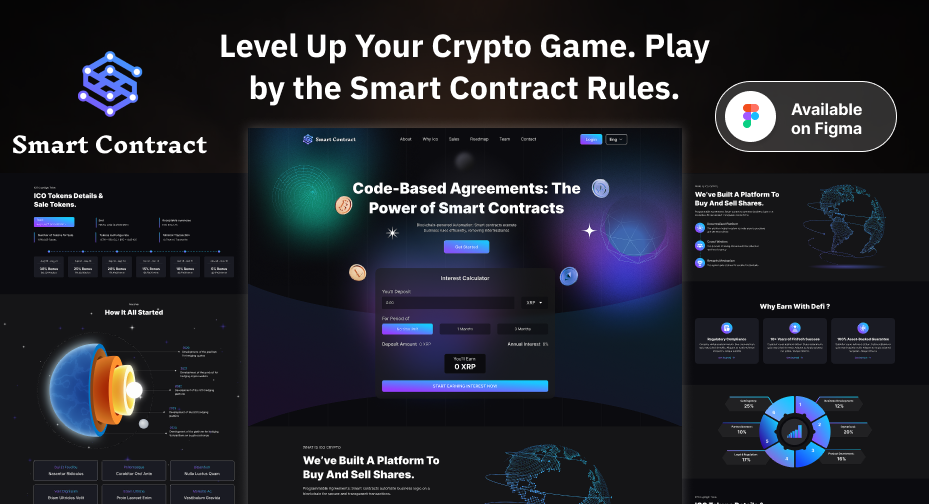
To start the website UI/UX design for a smart contract platform, you can go with the ready-made Figma kits. These kits are beyond just advanced-looking layouts. They include every component, like icons, design assets, color palette, menu, and compatibility to get code directly from the design.
If you need to explore more ready-made web development solutions, you can visit:
It’s better to explore the cost-effective option before going to a custom website development.
-
Smart Contract Website Template
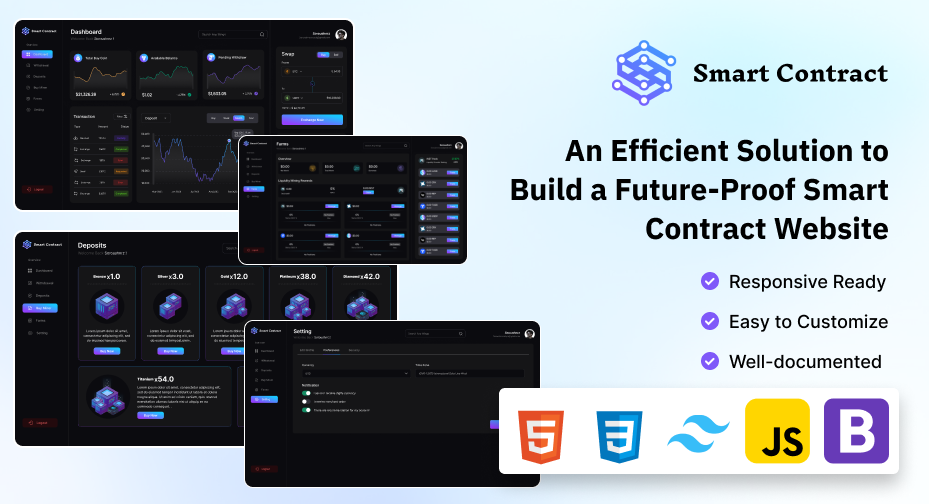
If you need a complete setup for a smart contract website optimized for speeding up the development, then a premium template like this will help. This template is made with HTML5, Tailwind CSS, and Bootstrap frontend technologies, including frameworks.
Step 5. Integrate Middleware and APIs
Middleware connects the blockchain layer with external systems and makes the website more versatile. APIs enable interaction with services outside the blockchain world.
-
Oracles: Bring in external data like stock prices, sports scores, or weather data to trigger contract actions.
-
Identity Verification: APIs for KYC/AML compliance allow businesses to meet legal requirements in regulated industries.
-
Enterprise Systems: Integration with CRMs, ERPs, or payment systems ensures blockchain platforms can work alongside existing workflows.
For example, an insurance dApp can use an oracle to fetch weather data. If rainfall exceeds a set threshold, the smart contract automatically releases payouts to affected users — no paperwork required.
Step 6. Wallet Integration
Wallets are the gateway for user interaction with blockchain. Instead of usernames and passwords, users authenticate and transact using crypto wallets.
Popular choices:
-
MetaMask – Browser extension wallet with wide adoption in Ethereum and compatible chains.
-
Trust Wallet – Mobile-friendly wallet supporting multiple blockchains.
-
WalletConnect – A protocol that allows users to connect different wallet apps seamlessly.
Without wallet integration, users wouldn’t be able to make payments or interact with smart contracts securely. For example, in a crowdfunding dApp, a wallet lets contributors fund projects instantly, while the smart contract updates ownership records automatically.
Step 7. Testing and Security Audits
Since smart contracts are immutable once deployed, testing is the most critical stage of development. Bugs can’t simply be patched later.
Testing methods for the smart contract managing website include:
-
Unit Tests: Validate that each function in the contract performs as expected.
-
Integration Tests: Ensure smooth communication between the frontend, backend, and blockchain.
-
Load Testing: Simulate high traffic to check if the website can handle heavy user activity.
-
Audits: External audits by firms like CertiK or OpenZeppelin identify security vulnerabilities before launch.
In 2022, smart contract exploits caused over $3 billion in losses in the DeFi sector. This highlights why security-first development is non-negotiable.
Prefer a professional QA & Testing service from experts to prevent loss and legal obligation.
Step 8. Deploying the Website
Deployment is when everything comes together.
-
Smart Contracts: Deployed to the chosen blockchain network (testnet first, then mainnet).
-
Frontend Hosting: Options include AWS or Google Cloud, or decentralized storage solutions like IPFS and Arweave for greater resilience.
-
Domains: Many projects now use ENS (Ethereum Name Service) or Unstoppable Domains for blockchain-based web addresses, making it easier for users to access dApps.
This step is where your smart contract website goes live, enabling real-world interaction.
Step 9. Maintenance and Upgrades
Launching a smart contract website is not the finished task. Continuous improvement is necessary for long-term success.
-
Feature Updates: Adding new modules like NFT trading, staking, or multi-chain support.
-
Optimization: Improving smart contract efficiency to reduce gas costs for users.
-
Regulatory Compliance: Updating the system to meet new laws, especially for fintech or healthcare solutions.
-
User Feedback: Gathering input to enhance UI/UX and ensure smooth adoption.
A well-maintained smart contract website can evolve with the business, ensuring it stays competitive and secure.
Common Challenges in Smart Contract Website Development
While smart contracts website development unlocks efficiency and trust, it comes with unique challenges that developers and businesses must anticipate.
1. Security Risks
Smart contracts are immutable once deployed, which means bugs can’t be patched easily. Exploits like reentrancy attacks have caused projects to lose millions.
Solution: Run thorough testing, use secure libraries like OpenZeppelin, and invest in professional audits.
2. Development Complexity
Unlike traditional web projects, building smart contract websites requires mastering Solidity, Rust, and blockchain protocols. This steep learning curve slows teams down.
Solution: Use frameworks like Hardhat or Truffle and speed up frontend work with ready tools such as the Smart Contract Web Template.
3. User Experience Barriers
Complex wallet setups, gas fees confusion, and technical details often frustrate non-technical users. Keep everything simple and clear to be understood.
Solution: Simplify UI/UX with clear prompts, guided wallet onboarding, and friendly error messages.
4. Scalability Issues
Public blockchains face congestion and high fees during peak demand. Don’t be tempted to pick those if they do not relate to your smart contract segment.
Solution: Adopt Layer 2 networks like Polygon or Optimism and optimize contract logic for efficiency.
5. Regulatory Concerns
Laws around digital assets and data privacy vary widely. A compliant website in one region may face restrictions in another.
Solution: Work with legal advisors and consider hybrid or private blockchain models when needed.
By preparing for these hurdles early, developers can deliver custom smart contract website solutions that are secure, user-friendly, and built to scale.
Conclusion
Smart contract websites are more than just a tech trend—they’re transforming how businesses operate in the digital age. These platforms help businesses automate transactions, cut costs, and build trust with customers, while giving developers a chance to innovate and create reliable solutions.
As digital assets and decentralized applications become increasingly mainstream, adopting smart contract websites is a strategic move for staying competitive, efficient, and future-ready in today’s fast-evolving market. With pre-made options like UI kits and templates, development is faster, but true success comes from secure blockchain integration, thorough testing, and a user-friendly design.
FAQs
- How do templates and UI kits help in development?
Templates and UI kits speed up development, provide pre-built components, and ensure responsive, modern designs, reducing cost and time-to-launch.
- Are smart contract websites scalable?
Yes, but scalability depends on blockchain choice and contract optimization. Layer 2 solutions like Polygon help reduce congestion and fees.
Which blockchain is best for smart contract websites?
Ethereum, Polygon, Solana, and Binance Smart Chain are popular choices. Selection depends on cost, speed, scalability, and network compatibility.
- Why should businesses use smart contract websites?
They reduce costs, increase transparency, improve security, and speed up processes, providing a competitive advantage and building trust with users.
- How do smart contracts work on a website?
Smart contracts are coded in languages like Solidity or Rust. They execute automatically when conditions are met, such as releasing payments, verifying ownership, or updating records.
- How is security ensured in smart contract websites?
Through audits, unit tests, integration tests, and by using secure libraries like OpenZeppelin to prevent exploits and vulnerabilities in the website.
 BTC - Bitcoin
BTC - Bitcoin
 USDTERC20 - USDT ERC20
USDTERC20 - USDT ERC20
 ETH - Ethereum
ETH - Ethereum
 BNB - Binance
BNB - Binance
 BCH - Bitcoin Cash
BCH - Bitcoin Cash
 DOGE - Dogecoin
DOGE - Dogecoin
 TRX - TRON
TRX - TRON
 USDTTRC20 - USD TRC20
USDTTRC20 - USD TRC20
 LTC - LiteCoin
LTC - LiteCoin


